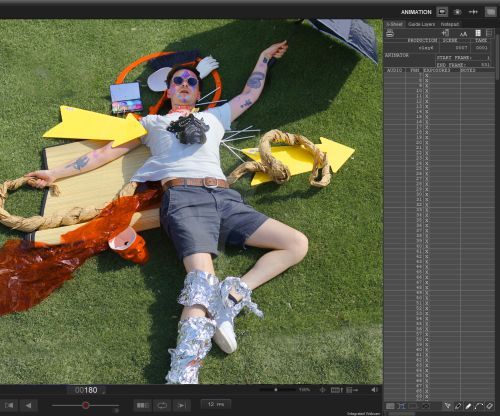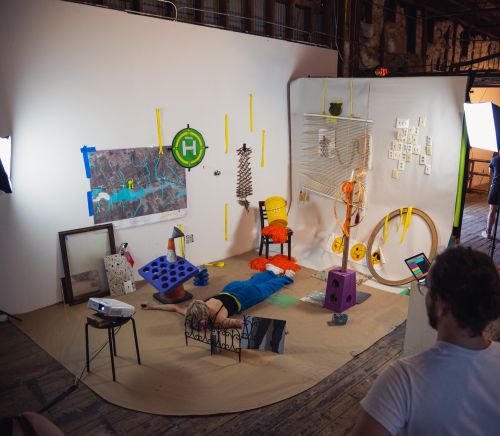Kit-bashing // input cycles: Difference between revisions
No edit summary |
No edit summary |
||
| (2 intermediate revisions by one other user not shown) | |||
| Line 1: | Line 1: | ||
{{Article | |||
|Is published=Yes | |||
|Date Published=2023-10-10 | |||
|Article authors=Sara Roma | |||
|Program=CATS+ | |||
|Categories=CATS+ Computer Club;CATS+ | |||
|Event=CATS+ Computer Club 6: Stop Motion Animation, CATS+ Out of the Bag | |||
}} | |||
''This is an artist page by [[Sara Roma]]. This project was part of the 2023 [[CATS+ Computer Club]] cohort.'' | ''This is an artist page by [[Sara Roma]]. This project was part of the 2023 [[CATS+ Computer Club]] cohort.'' | ||
| Line 98: | Line 106: | ||
== Related links == | == Related links == | ||
*[https://www.sara-roma.com/ Sara's website] | *[https://www.sara-roma.com/ Sara's website] | ||
Latest revision as of 15:52, April 3, 2024
This is an artist page by Sara Roma. This project was part of the 2023 CATS+ Computer Club cohort.
kit bashing / input cycles is a LIVE audience-generated pixilation stop-motion performance. Its first iteration was created and performed for CATS+ Out of the Bag.
The themes of this iteration were inspired by Sara Roma’s previous work in time based media and interest in performance, as well as conversations with the cohort during the CATS+ Computer Club sessions.
During the piece the puppet-performer is directed by the audience via several commands on an Ipad. Over the course of an hour the performer takes several photos for each command, moving in-between each shot and remaining mindful of the resulting video frames. After each command is submitted a PROGRESS bar moves either up or down.
Through the interaction the audience is invited to participate in the time modulation with the performer as well as exercise collective control over PROGRESS. The resulting video becomes a timelapse of the interactions of collaboration and control as well as the interplay of different “framerates” embodied by objects on the set (including mirrors which catch movement of the audience.)
Pixilation Workshop
Intro
During the CATS+ Computer Club, Sara Roma led a workshop on pixilation. This delivered an entry level overview on animation techniques, showcased styles of stop-motion animation, and demonstrated the software Dragonframe. The goal of the workshop was to show stop-motion as a fun and accessible way to make animations, enhance photography, and express creativity, as well as generate ideas for the creation of “kit-bashing // input cycles”.
Framerate
Framerate is how we measure our animation. The cinema standard is 24 frames per second, this is good for stop-motion because it divides neatly when planning out motion. However it’s very common for stop-motion to have holds or be shot on “twos” or even “threes”. Shooting on “ones” means taking a picture for every frame, shooting on “twos” is taking two pictures for each frame or holding each single picture for two frames. To keep track of keyframes and motion, traditional 2D animation and stop-motion uses x-sheets. When using Dragonframe the x-sheet is in a window on the right hand side of screen.
Styles of stop-motion
Several styles of popular stop-motion include claymation, object-motion, cut-out motion, pixilation,strata-cut, and puppet (or what Sara Roma sometimes calls Laika-core).
Pixilation
Pixilation is a stop motion technique in which live actors are used as a frame-by-frame subject in an animated film, by repeatedly posing while one or more frame is taken and changing pose slightly before the next frame or frames. The actor becomes a kind of living stop-motion puppet.
Animation Fundamentals
The animation bible is the “animator's survival kit” which looks at the 12 principles of animation which were written by “the nine old men” who were animators at disney in the early days (1930-40).
12 principles
- Timing and Spacing
- Squash and Stretch
- Anticipation
- Ease In and Ease Out
- Follow Through and Overlapping Action
- Arcs
- Exaggeration
- Solid Drawing
- Appeal
- Straight Ahead Action and Pose to Pose
- Secondary Action
- Staging
Further Applications and Integrations with Technology
Due to the nature of CATS+ bringing together technical skills alongside other artistic talents the workshop highlighted several advancements and tools that are at the forefront of the creation of stop-motion.
Depth-aware Video Frame Interpolation
New AI tool was tested with stop-motion to increase a low frame rate video to 60 fps. Using the neural network called DAIN youtuber LegoEddy shows how a LEGO Brickfilm can be interpolated from 12 fps to 60 fps.
Other Tech Crossovers
- 3D printing (Laika uses this for their facial animation, but there are many ways to incorporate 3D printing in fabrication).
- Photogrammetry (A postgraduate study was done on 3D scanning each frame of a puppeted stop-motion so that it could be used in a virtual 3D environment for VR).
- Motion Control (Programmed rigs for cameras and lights that create precise movement).
- Projection mapping (Opportunities for digital/physical crossover)
- Lasers
Audience-generated Pixilation Stop-motion Performance
Commands and Audience Interaction
A key aspect of kit-bashing // input cycles were the commands the audience were allowed to choose from to direct the puppet-performer. The commands and the vehicle for submission shifted a lot in the ideation process. It was decided for this iteration an ipad would be used for input. Using p5 Kristine created a display for 5 commands, a queue, and a progress bar. You can read more about her process here. The commands chosen for the performance were: attract, vertical, chair, reward, and spin.
Loosely the commands meant the following: attract- move towards a random object with sudden attraction, vertical- move puppet or object up or down, reward- puppet or object receives star stickers, or a hug, chair- chair pose, chair move, puppet sits in chair, and spin- spin puppet or body part of puppet, or object.
Progress Bar
The CATS+ collaboration led to the concept of a progress bar as an aspect of “kit-bashing // input cycles”. Kristine mentioned how frequently a progress bar is not programmed to be tied to any element and instead is shown just to comfort a viewer as they wait. This was appealing as a cornerstone to the concept and included in this iteration.
Kit-bashing
The piece is named kit-bashing because it sounds nice. It’s almost like button mashing. Which is similar to the frustration one may face when attempting to control an unruly puppet-performer with no idea what progress means and how to achieve it. The act of kit-bashing is also pretty punk, diy, object-centric, and related to stop-motion and film fabrication. Kit-bashing is the practice of making a new scale model by taking pieces out of kits. It’s been used for films to speed up fabrication. Specifically in some very popular sci-fi films. It’s possible our approach to understanding most things could be comparable to kit-bashing, a mash-up of self made concepts and “kits” supplied to us already. From our understanding of time to our approach towards progressive change.
Concepts
In some ways the ideas kit-bashing // input cycles are still in progress. But the various seeds of concepts will be documented here.
Starting with the form of the piece, there was an intent to explore the body and control. Giving up control to not just one audience member at a time to generate real-time actions, but instead giving the entire audience say over the minutiae of movement. They become active directors in a continuous expanded flow. This audience performer relationship intends to blur the differences between the action of an individual body and a collective body. Allowing the metaphor of progress to apply to the puppet-performer, the set, and audience.
The nature of the commands alluded towards the fuzziness of language, from commanding genies in myths, manifesting for ourselves in wellness or magick, or prompting AI. While the audience had the choice over commands, the puppet-performer was able to interpret chair as chair-pose, moving the chair, or sitting in the chair. Through play the audience can learn the ways the puppet-performer interprets the language as well as potentially realize the arbitrary nature of the progress bar.
The progress bar became a symbol for this fuzziness. The difficulty in pinning down who was in control, what a goal may be, and how these photos would end up measuring time when played back. The resulting aesthetic of the set was based around ideas of construction and building, or in other words: a snapshot of our idea of linear progress. A constant building upwards put under a microscope and slowed down. What you got in real time was a body staring at a cardboard tube made to look like a tree for 3 minutes, but in the video, a spinning, living actor and object.
The resulting video becomes a timelapse of the interactions of collaboration and control as well as the interplay of different “framerates” embodied by objects on the set (including mirrors which catch movement of the audience.) In the end an audience can see the collective actions as a snapshot of linear time played back from second 0 to the end of the captured frames. Another arbitrary measurement of progress across time.
Questions
In which ways are individual bodies and collective bodies the same? How do they move between autonomy and influences outside their boundaries? How do we control and measure progress? What could it mean to embody an object? What can objects operating on different time scales teach us? Such as trees, insects, geology, waterways, bird migration patterns, or cyclical processes. How can reflection on the scale we use change the way we see our surroundings? What “kits” in your life could use more custom bashing?
Further Inspirations
Stop-motion
- https://www.youtube.com/watch?v=e_aSowDUUaY
- https://www.youtube.com/watch?v=lYwAzLlUbV8
- https://www.youtube.com/watch?v=OJWJE0x7T4Q&t=2s
- https://www.tiktok.com/@mollymoonn2/video/7188704656175156526
- https://www.instagram.com/p/CMUpeKWnaIJ/?hl=en



